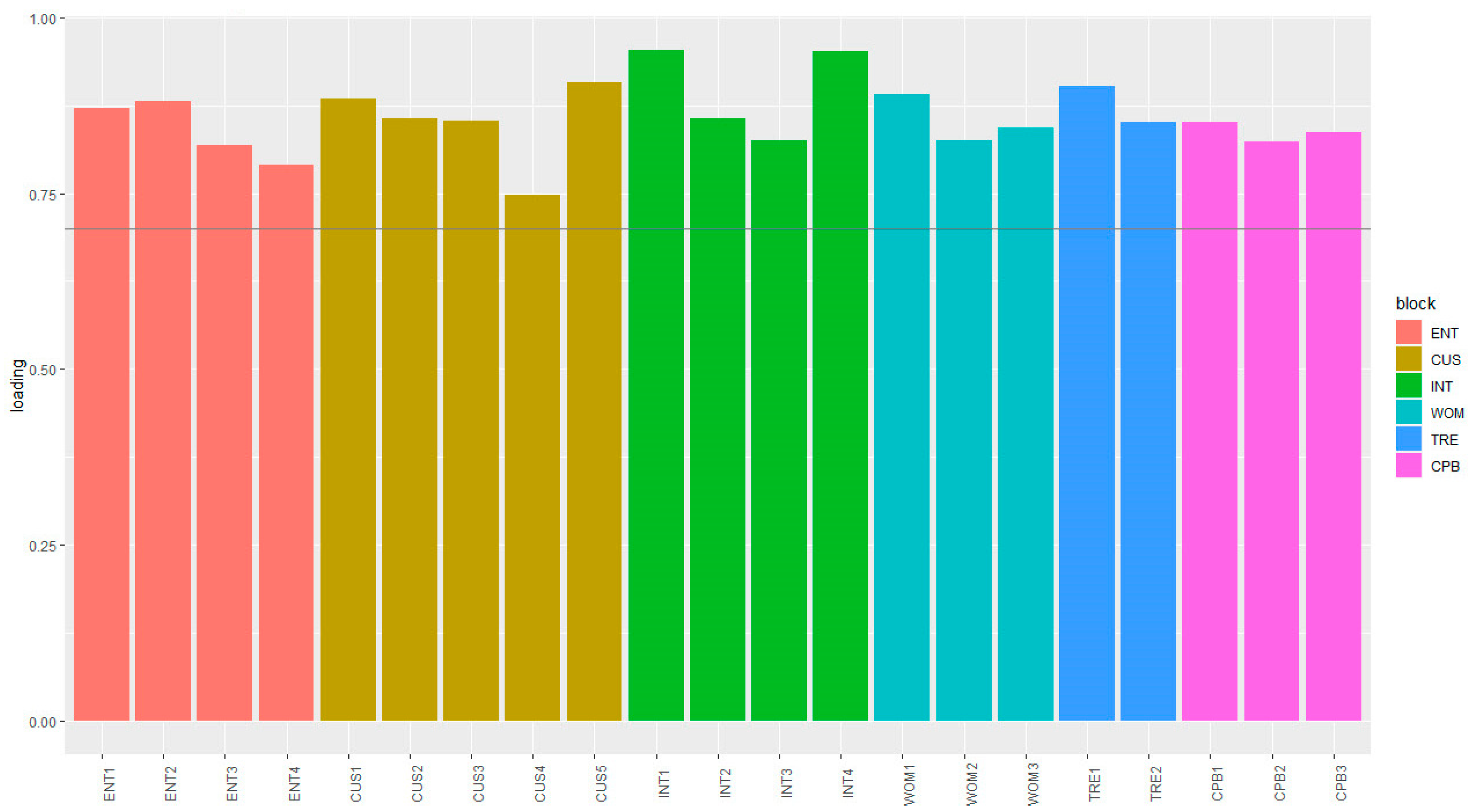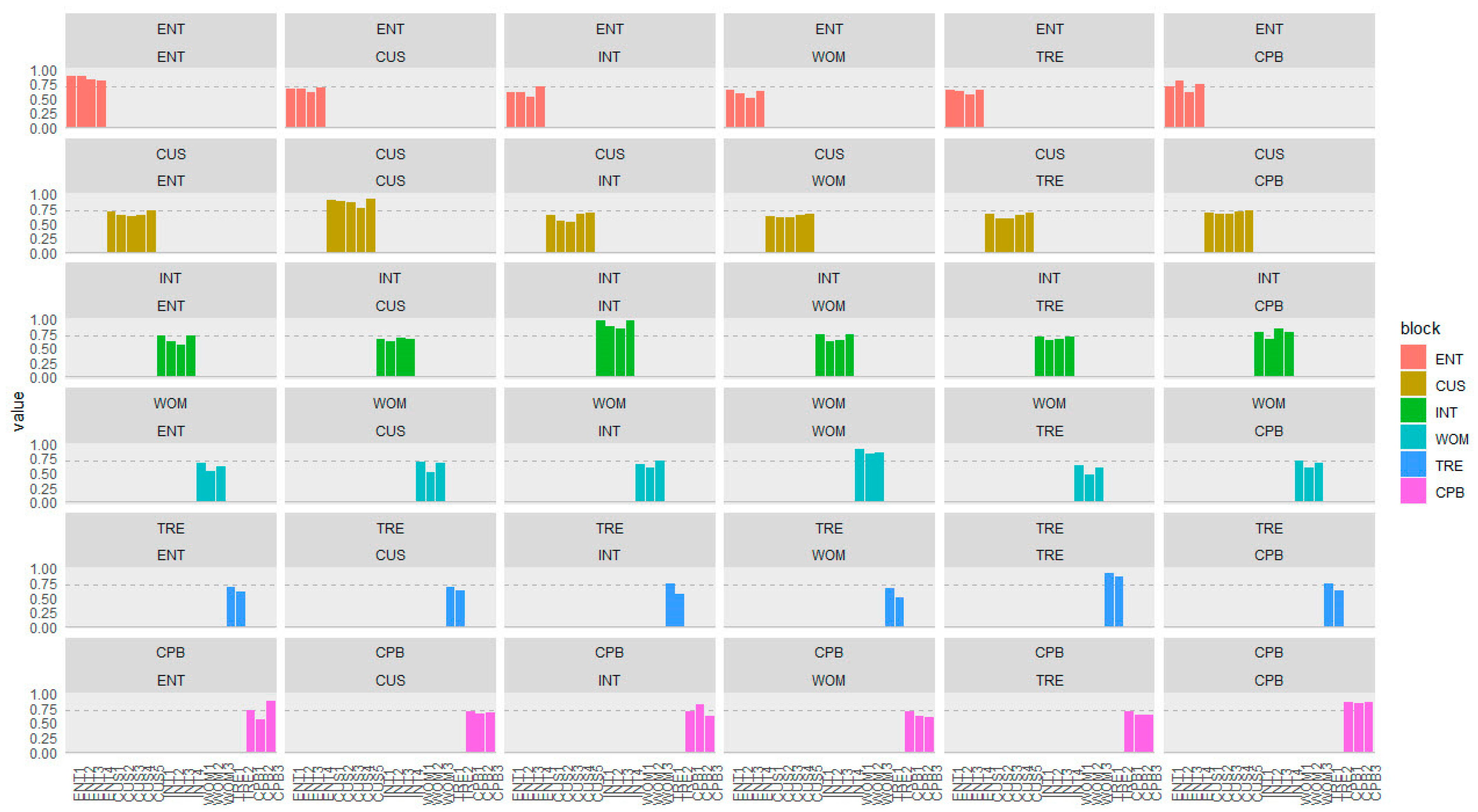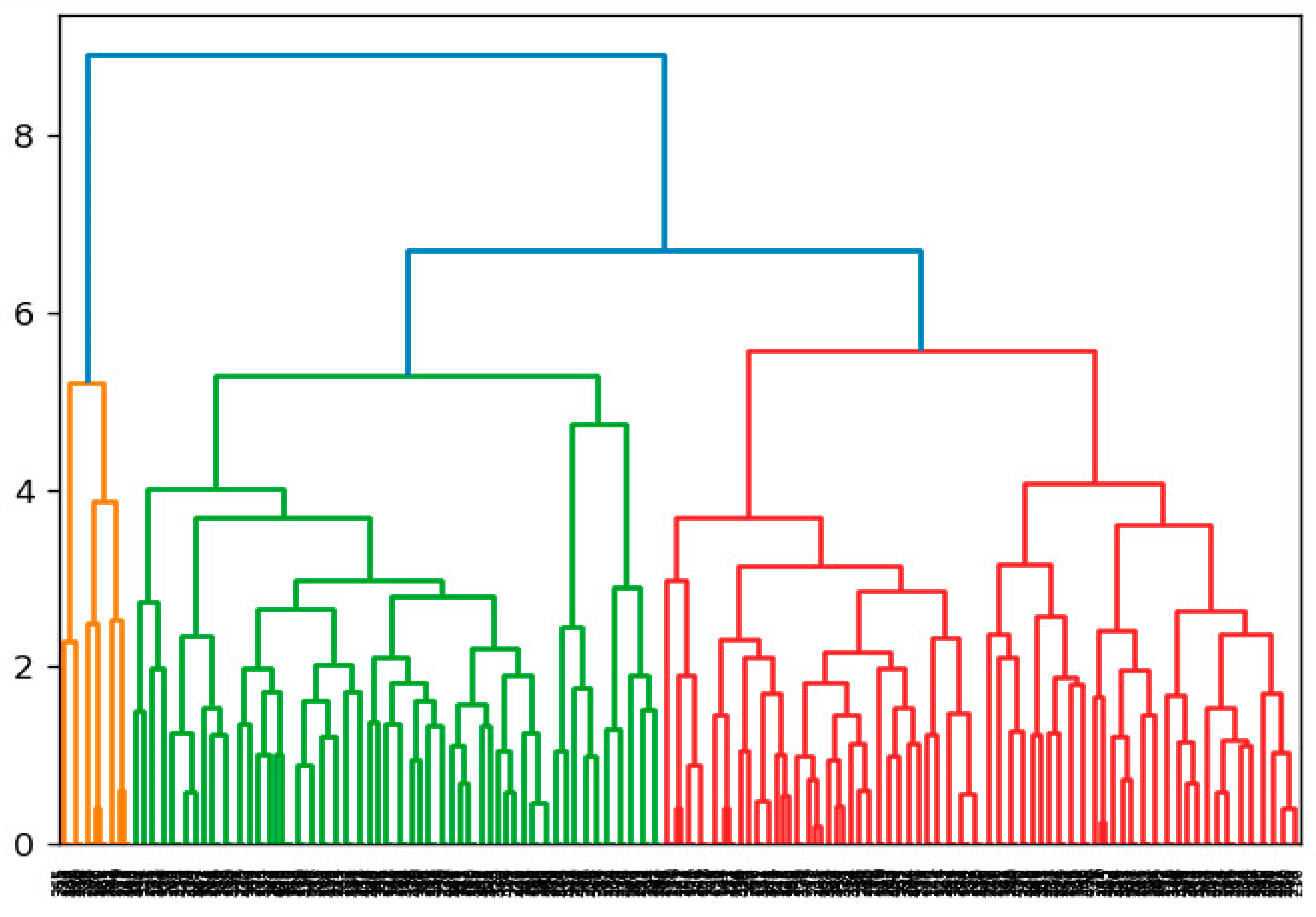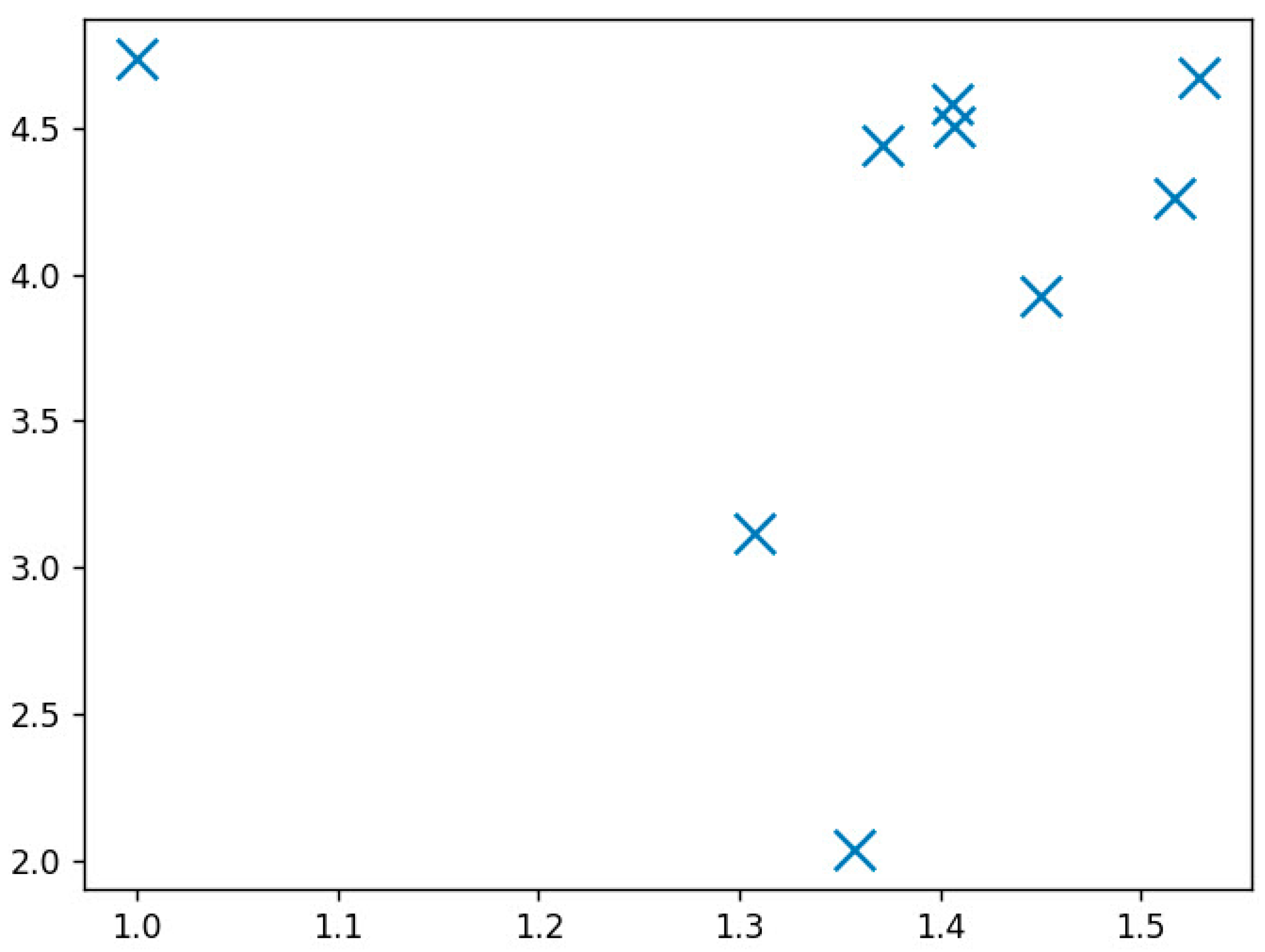Social Networks Marketing and Consumer Purchase Behavior: The Combination of SEM and Unsupervised Machine Learning Approaches
Abstract
:1. Introduction
2. Literature Review and Hypotheses Development
2.1. Theoretical Background: Choice Theory
2.2. Social Networks Marketing
2.3. Consumer Purchase Behavior
2.4. Conceptual Framework of Social Networks Marketing, Consumer Purchase Behavior and Its Five Measures
3. Research Method
Sample Size and Measurement of Constructs
4. Results
4.1. Measurement Models
4.2. Structural Model
4.3. Application of Unsupervised Machine Learning Approach
5. Discussion
6. Conclusions, Managerial Implications, Limitations, and Suggestions
Author Contributions
Funding
Institutional Review Board Statement
Informed Consent Statement
Data Availability Statement
Conflicts of Interest
Appendix A
References
- Ryu, S.; Park, J. The effects of benefit-driven commitment on usage of social media for shopping and positive word-of-mouth. J. Retail. Consum. Serv. 2020, 55, 102094. [Google Scholar] [CrossRef]
- Wiese, M.; Martínez-Climent, C.; Botella-Carrubi, D. A framework for Facebook advertising effectiveness: A behavioral perspective. J. Bus. Res. 2020, 109, 76–87. [Google Scholar] [CrossRef]
- Chen, J.V.; Su, B.-c.; Widjaja, A.E. Facebook C2C social commerce: A study of online impulse buying. Decis. Support Syst. 2016, 83, 57–69. [Google Scholar] [CrossRef]
- Bughin, J. Getting a sharper picture of social media’s influence. McKinsey Q. 2015, 3, 8–11. [Google Scholar]
- Dwivedi, Y.K.; Ismagilova, E.; Hughes, D.L.; Carlson, J.; Filieri, R.; Jacobson, J.; Jain, V.; Karjaluoto, H.; Kefi, H.; Krishen, A.S. Setting the future of digital and social media marketing research: Perspectives and research propositions. Int. J. Inf. Manag. 2021, 59, 102168. [Google Scholar] [CrossRef]
- Vithayathil, J.; Dadgar, M.; Osiri, J.K. Social media use and consumer shopping preferences. Int. J. Inf. Manag. 2020, 54, 102117. [Google Scholar] [CrossRef]
- Ajina, A.S. The perceived value of social media marketing: An empirical study of online word-of-mouth in Saudi Arabian context. Entrep. Sustain. Issues 2019, 6, 1512. [Google Scholar] [CrossRef] [Green Version]
- Mangold, W.G.; Faulds, D.J. Social media: The new hybrid element of the promotion mix. Bus. Horiz. 2009, 52, 357–365. [Google Scholar] [CrossRef]
- Statista. Number of Facebook Users in Hungary from September 2018 to January 2022. 2022. Available online: https://www.statista.com/statistics/1029770/facebook-users-hungary/ (accessed on 1 March 2021).
- Pop, R.-A.; Săplăcan, Z.; Alt, M.-A. Social media goes green—The impact of social media on green cosmetics purchase motivation and intention. Information 2020, 11, 447. [Google Scholar] [CrossRef]
- Husnain, M.; Toor, A. The impact of social network marketing on consumer purchase intention in Pakistan: Consumer engagement as a mediator. Asian J. Bus. Account. 2017, 10, 167–199. [Google Scholar]
- Di Pietro, L.; Pantano, E. An empirical investigation of social network influence on consumer purchasing decision: The case of Facebook. J. Direct Data Digit. Mark. Pract. 2012, 14, 18–29. [Google Scholar] [CrossRef]
- Boon-Long, S.; Wongsurawat, W. Social media marketing evaluation using social network comments as an indicator for identifying consumer purchasing decision effectiveness. J. Direct Data Digit. Mark. Pract. 2015, 17, 130–149. [Google Scholar] [CrossRef] [Green Version]
- Ebrahimi, P.; Khajeheian, D.; Fekete-Farkas, M. A SEM-NCA Approach towards Social Networks Marketing: Evaluating Consumers’ Sustainable Purchase Behavior with the Moderating Role of Eco-Friendly Attitude. Int. J. Environ. Res. Public Health 2021, 18, 13276. [Google Scholar] [CrossRef] [PubMed]
- Tussyadiah, I.P. A concept of location-based social network marketing. J. Travel Tour. Mark. 2012, 29, 205–220. [Google Scholar] [CrossRef]
- Fagerstrøm, A.; Ghinea, G. Co-creation of value in higher education: Using social network marketing in the recruitment of students. J. High. Educ. Policy Manag. 2013, 35, 45–53. [Google Scholar] [CrossRef]
- Van Noort, G.; Antheunis, M.L.; Verlegh, P.W. Enhancing the effects of social network site marketing campaigns: If you want consumers to like you, ask them about themselves. Int. J. Advert. 2014, 33, 235–252. [Google Scholar] [CrossRef]
- Ajzen, I. Perceived Behavioural Control, Self-efficacy, Locus of Control and the Theory of Planned Behaviour. J. Appl. Soc. Psychol. 2002, 32, 668–683. [Google Scholar] [CrossRef]
- Fishbein, M.; Ajzen, I. Predicting and understanding consumer behavior: Attitude-behavior correspondence. In Understanding Attitudes and Predicting Social Behavior; Prentice-Hall: Englewood Cliffs, NJ, USA, 1980; pp. 148–172. ISBN 0-13-936435-8. [Google Scholar]
- Rogers, E.M. Diffusion of Innovations; Collier Macmillan: London, UK, 1983. [Google Scholar]
- Venkatesh, V.; Morris, M.G.; Davis, G.B.; Davis, F.D. User acceptance of information technology: Toward a unified view. MIS Q. 2003, 27, 425–478. [Google Scholar] [CrossRef] [Green Version]
- Glasser, W. Choice Theory: A New Psychology of Personal Freedom; Harper Perennial: New York, NY, USA, 1999. [Google Scholar]
- Loureiro, S.M.C.; Guerreiro, J.; Ali, F. 20 years of research on virtual reality and augmented reality in tourism context: A text-mining approach. Tour. Manag. 2020, 77, 104028. [Google Scholar] [CrossRef]
- Mirbargkar, S.M.; Ebrahimi, P.; Soleimani, M. ANT and Mobile Network Service Adoption in Banking Industry. In Contemporary Applications of Actor Network Theory; Palgrave Macmillan: London, UK; Springer Nature Singapore Pte Ltd.: Singapore, 2020; pp. 155–172. [Google Scholar]
- Statista. Worldwide Digital Population as of January 2021. 2021. Available online: https://www.statista.com/statistics/617136/digital-population-worldwide/ (accessed on 5 January 2021).
- Statista. Number of Monthly Active Facebook Users Worldwide as of 4th Quarter 2021. 2021. Available online: https://www.statista.com/statistics/264810/number-of-monthly-active-facebook-users-worldwide/ (accessed on 14 February 2021).
- Liang, T.-P.; Turban, E. Introduction to the special issue social commerce: A research framework for social commerce. Int. J. Electron. Commer. 2011, 16, 5–14. [Google Scholar] [CrossRef] [Green Version]
- Chang, H.H.; Lu, Y.-Y.; Lin, S.C. An elaboration likelihood model of consumer respond action to facebook second-hand marketplace: Impulsiveness as a moderator. Inf. Manag. 2020, 57, 103171. [Google Scholar] [CrossRef]
- Abou-Elgheit, E. Understanding Egypt’s emerging social shoppers. Middle East J. Manag. 2018, 5, 207–270. [Google Scholar] [CrossRef]
- Hanna, R.; Rohm, A.; Crittenden, V.L. We’re all connected: The power of the social media ecosystem. Bus. Horiz. 2011, 54, 265–273. [Google Scholar] [CrossRef]
- Shukla, P.S.; Nigam, P.V. E-shopping using mobile apps and the emerging consumer in the digital age of retail hyper personalization: An insight. Pac. Bus. Rev. Int. 2018, 10, 131–139. [Google Scholar]
- Mikalef, P.; Pateli, A.; Giannakos, M. Why are users of Social Media inclined to Word-of-Mouth? In Proceedings of the Conference on e-Business, e-Services and e-Society, Athens, Greece, 25–26 April 2013; Springer: Berlin/Heidelberg, Germany, 2013; pp. 112–123. [Google Scholar]
- Culnan, M.J.; McHugh, P.J.; Zubillaga, J.I. How large US companies can use Twitter and other social media to gain business value. MIS Q. Exec. 2010, 9, 243–259. [Google Scholar]
- Bhattacharyya, S.; Bose, I. S-commerce: Influence of Facebook likes on purchases and recommendations on a linked e-commerce site. Decis. Support Syst. 2020, 138, 113383. [Google Scholar] [CrossRef]
- Lee, K.; Lee, B.; Oh, W. Thumbs up, sales up? The contingent effect of Facebook likes on sales performance in social commerce. J. Manag. Inf. Syst. 2015, 32, 109–143. [Google Scholar] [CrossRef]
- Liu, S.Q.; Ozanne, M.; Mattila, A.S. Does expressing subjectivity in online reviews enhance persuasion? J. Consum. Mark. 2018, 35, 403–413. [Google Scholar] [CrossRef]
- Xu, X.; Zeng, S.; He, Y. The impact of information disclosure on consumer purchase behavior on sharing economy platform Airbnb. Int. J. Prod. Econ. 2021, 231, 107846. [Google Scholar] [CrossRef]
- Weismueller, J.; Harrigan, P.; Wang, S.; Soutar, G.N. Influencer endorsements: How advertising disclosure and source credibility affect consumer purchase intention on social media. Australas. Mark. J. 2020, 28, 160–170. [Google Scholar] [CrossRef]
- Hasan, M.; Sohail, M.S. The influence of social media marketing on consumers’ purchase decision: Investigating the effects of local and nonlocal brands. J. Int. Consum. Mark. 2021, 33, 350–367. [Google Scholar] [CrossRef]
- Ng, C.S.-P. Intention to purchase on social commerce websites across cultures: A cross-regional study. Inf. Manag. 2013, 50, 609–620. [Google Scholar] [CrossRef]
- Kang, M.Y.; Park, B. Sustainable corporate social media marketing based on message structural features: Firm size plays a significant role as a moderator. Sustainability 2018, 10, 1167. [Google Scholar] [CrossRef] [Green Version]
- Ch, T.R.; Awan, T.M.; Malik, H.A.; Fatima, T. Unboxing the green box: An empirical assessment of buying behavior of green products. World J. Entrep. Manag. Sustain. Dev. 2021, 17, 690–710. [Google Scholar] [CrossRef]
- Kong, H.M.; Witmaier, A.; Ko, E. Sustainability and social media communication: How consumers respond to marketing efforts of luxury and non-luxury fashion brands. J. Bus. Res. 2021, 131, 640–651. [Google Scholar] [CrossRef]
- Whang, J.B.; Song, J.H.; Choi, B.; Lee, J.-H. The effect of Augmented Reality on purchase intention of beauty products: The roles of consumers’ control. J. Bus. Res. 2021, 133, 275–284. [Google Scholar] [CrossRef]
- Rapert, M.I.; Thyroff, A.; Grace, S.C. The generous consumer: Interpersonal generosity and pro-social dispositions as antecedents to cause-related purchase intentions. J. Bus. Res. 2021, 132, 838–847. [Google Scholar] [CrossRef]
- Sung, Y.H.; Kim, D.H.; Choi, D.; Lee, S.Y. Facebook ads not working in the same way: The effect of cultural orientation and message construals on consumer response to social media ads. Telemat. Inform. 2020, 52, 101427. [Google Scholar] [CrossRef]
- Cunningham, S.; Craig, D. Creator governance in social media entertainment. Soc. Media+Soc. 2019, 5, 2056305119883428. [Google Scholar] [CrossRef] [Green Version]
- Kim, A.J.; Ko, E. Do social media marketing activities enhance customer equity? An empirical study of luxury fashion brand. J. Bus. Res. 2012, 65, 1480–1486. [Google Scholar] [CrossRef]
- Schmenner, R.W. How can service businesses survive and prosper? Sloan Manag. Rev. 1986, 27, 21–32. [Google Scholar]
- Ding, Y.; Keh, H.T. A re-examination of service standardization versus customization from the consumer’s perspective. J. Serv. Mark. 2016, 30, 16–28. [Google Scholar] [CrossRef]
- Nekmahmud, M.; Fekete-Farkas, M. Why not green marketing? Determinates of consumers’ intention to green purchase decision in a new developing nation. Sustainability 2020, 12, 7880. [Google Scholar] [CrossRef]
- Kaplan, A.M.; Haenlein, M. Users of the world, unite! The challenges and opportunities of Social Media. Bus. Horiz. 2010, 53, 59–68. [Google Scholar] [CrossRef]
- Daugherty, T.; Eastin, M.S.; Bright, L. Exploring consumer motivations for creating user-generated content. J. Interact. Advert. 2008, 8, 16–25. [Google Scholar] [CrossRef]
- Muntinga, D.G.; Moorman, M.; Smit, E.G. Introducing COBRAs: Exploring motivations for brand-related social media use. Int. J. Advert. 2011, 30, 13–46. [Google Scholar] [CrossRef]
- Kotler, P.; Wong, V.; Saunders, J.; Armstrong, G. Principles of Marketing; Pearson Education: London, UK, 2007. [Google Scholar]
- Gonda, G.; Gorgenyi-Hegyes, E.; Nathan, R.J.; Fekete-Farkas, M. Competitive factors of fashion retail sector with special focus on SMEs. Economies 2020, 8, 95. [Google Scholar] [CrossRef]
- Ghafourian Shagerdi, A.; Daneshmand, B.; Behboodi, O. The Impact of Social Networks Marketing toward Purchase Intention and Brand Loyalty. New Mark. Res. J. 2017, 7, 175–190. [Google Scholar]
- Vollmer, C.; Precourt, G. Always on: Advertising, Marketing, and Media in an Era of Consumer Control; McGraw Hill Professional: New York, NY, USA, 2008. [Google Scholar]
- Naaman, M.; Becker, H.; Gravano, L. Hip and trendy: Characterizing emerging trends on Twitter. J. Am. Soc. Inf. Sci. Technol. 2011, 62, 902–918. [Google Scholar] [CrossRef] [Green Version]
- Godey, B.; Manthiou, A.; Pederzoli, D.; Rokka, J.; Aiello, G.; Donvito, R.; Singh, R. Social media marketing efforts of luxury brands: Influence on brand equity and consumer behavior. J. Bus. Res. 2016, 69, 5833–5841. [Google Scholar] [CrossRef]
- Oláh, J.; Kitukutha, N.; Haddad, H.; Pakurár, M.; Máté, D.; Popp, J. Achieving sustainable e-commerce in environmental, social and economic dimensions by taking possible trade-offs. Sustainability 2019, 11, 89. [Google Scholar] [CrossRef] [Green Version]
- Alshurideh, M.; Al Kurdi, B.; Salloum, S.A.; Arpaci, I.; Al-Emran, M. Predicting the actual use of m-learning systems: A comparative approach using PLS-SEM and machine learning algorithms. Interact. Learn. Environ. 2020, 1–15. [Google Scholar] [CrossRef]
- Podsakoff, P.M.; MacKenzie, S.B.; Lee, J.-Y.; Podsakoff, N.P. Common method biases in behavioral research: A critical review of the literature and recommended remedies. J. Appl. Psychol. 2003, 88, 879. [Google Scholar] [CrossRef] [PubMed]
- Ebrahimi, P.; Salamzadeh, A.; Gholampour, A.; Fekete-Farkas, M. Social networks marketing and Hungarian online consumer purchase behavior: The microeconomics strategic view based on IPMA matrix. Acad. Strateg. Manag. J. 2021, 20, 1–7. [Google Scholar]
- Kim, A.J.; Ko, E. Impacts of luxury fashion brand’s social media marketing on customer relationship and purchase intention. J. Glob. Fash. Mark. 2010, 1, 164–171. [Google Scholar] [CrossRef]
- Ebrahimi, P.; Hamza, K.A.; Gorgenyi-Hegyes, E.; Zarea, H.; Fekete-Farkas, M. Consumer Knowledge Sharing Behavior and Consumer Purchase Behavior: Evidence from E-Commerce and Online Retail in Hungary. Sustainability 2021, 13, 10375. [Google Scholar] [CrossRef]
- Ghahtarani, A.; Sheikhmohammady, M.; Rostami, M. The impact of social capital and social interaction on customers’ purchase intention, considering knowledge sharing in social commerce context. J. Innov. Knowl. 2020, 5, 191–199. [Google Scholar] [CrossRef]
- Kumar, A.; Kim, Y.K.; Pelton, L. Indian consumers’ purchase behavior toward US versus local brands. Int. J. Retail Distrib. Manag. 2009, 37, 510–526. [Google Scholar] [CrossRef]
- Janavi, E.; Soleimani, M.; Gholampour, A.; Friedrichsen, M.; Ebrahimi, P. Effect of Social Media Adoption and Media Needs on Online Purchase Behavior: The Moderator Roles of Media Type, Gender, Age. J. Inf. Technol. Manag. 2021, 13, 1–24. [Google Scholar]
- Yang, X. Understanding Consumers’ Purchase Intentions in Social Commerce through Social Capital: Evidence from SEM and fsQCA. J. Theor. Appl. Electron. Commer. Res. 2021, 16, 1557–1570. [Google Scholar] [CrossRef]
- Bouzari, P.; Salamzadeh, A.; Soleimani, M.; Ebrahimi, P. Online Social Networks and Women’s Entrepreneurship: A Comparative Study between Iran and Hungary. JWEE 2021, 3–4, 61–75. [Google Scholar] [CrossRef]
- Fekete-Farkas, M.; Gholampour, A.; Bouzari, P.; Jarghooiyan, H.; Ebrahimi, P. How gender and age can affect consumer purchase behavior? Evidence from A microeconomic perspective from Hungary. AD-Minister 2021, 39, 25–46. [Google Scholar] [CrossRef]
- Khajeheian, D.; Ebrahimi, P. Media branding and value co-creation: Effect of user participation in social media of newsmedia on attitudinal and behavioural loyalty. Eur. J. Int. Manag. 2021, 16, 499–528. [Google Scholar] [CrossRef]
- Roshandel-Arbatani, T.; Kawamorita, H.; Ghanbary, S.; Ebrahimi, P. Modelling media entrepreneurship in social media: SEM and MLP-ANN Approach. AD-Minister 2019, 34, 35–57. [Google Scholar]
- Sanchez, G. PLS Path Modeling with R; Trowchez, Ed.; University of California Berkeley: Berkeley, CA, USA, 2013; Volume 383, pp. 3–221. [Google Scholar]
- Hair, J.F., Jr.; Sarstedt, M.; Ringle, C.M.; Gudergan, S.P. Advanced Issues in Partial Least Squares Structural Equation Modeling; SAGE Publications: Thousand Oaks, CA, USA, 2016. [Google Scholar]
- Hair, J.F.; Risher, J.J.; Sarstedt, M.; Ringle, C.M. When to use and how to report the results of PLS-SEM. Eur. Bus. Rev. 2019, 31, 2–24. [Google Scholar] [CrossRef]
- Soleimani, M.; Ebrahimi, P.; Fekete-Farkas, M. The impact of corporate social responsibility dimensions on brand-related consequences with the mediating role of corporate branding—A case study from the iranian insurance sector. In Forum Scientiae Oeconomia; Scientific Publishers of the WSB Academy: Dąbrowa Górnicza, Poland, 2021. [Google Scholar]
- Henseler, J.; Ringle, C.M.; Sarstedt, M. A new criterion for assessing discriminant validity in variance-based structural equation modeling. J. Acad. Mark. Sci. 2015, 43, 115–135. [Google Scholar] [CrossRef] [Green Version]
- Hair, J.F.; Henseler, J.; Dijkstra, T.K.; Sarstedt, M. Common beliefs and reality about partial least squares: Comments on Rönkkö and Evermann. Organ. Res. Methods 2014, 17, 182–209. [Google Scholar] [CrossRef] [Green Version]
- Ebrahimi, P.; Ahmadi, M.; Gholampour, A.; Alipour, H. CRM performance and development of media entrepreneurship in digital, social media and mobile commerce. Int. J. Emerg. Mark. 2021, 16, 25–50. [Google Scholar] [CrossRef]
- Koren, D.; Lőrincz, L.; Kovács, S.; Kun-Farkas, G.; Vecseriné Hegyes, B.; Sipos, L. Comparison of supervised learning statistical methods for classifying commercial beers and identifying patterns. J. Chemom. 2020, 34, e3216. [Google Scholar] [CrossRef]
- Berry, M.W.; Mohamed, A.; Yap, B.W. Supervised and Unsupervised Learning for Data Science; Springer: Berlin/Heidelberg, Germany, 2019. [Google Scholar]
- Marshal, S. Machine Learning an Algorithm Perspective; CRC Press: Boca Raton, FL, USA, 2015. [Google Scholar]
- Cheung, M.L.; Pires, G.D.; Rosenberger, P.J.; Leung, W.K.; Sharipudin, M.-N.S. The role of consumer-consumer interaction and consumer-brand interaction in driving consumer-brand engagement and behavioral intentions. J. Retail. Consum. Serv. 2021, 61, 102574. [Google Scholar] [CrossRef]
- Moslehpour, M.; Dadvari, A.; Nugroho, W.; Do, B.-R. The dynamic stimulus of social media marketing on purchase intention of Indonesian airline products and services. Asia Pac. J. Mark. Logist. 2020, 33, 561–583. [Google Scholar] [CrossRef]
- Farman, L.; Comello, M.L.; Edwards, J.R. Are consumers put off by retargeted ads on social media? Evidence for perceptions of marketing surveillance and decreased ad effectiveness. J. Broadcast. Electron. Media 2020, 64, 298–319. [Google Scholar] [CrossRef]
- Hutter, K.; Hautz, J.; Dennhardt, S.; Füller, J. The impact of user interactions in social media on brand awareness and purchase intention: The case of MINI on Facebook. J. Prod. Brand Manag. 2013, 22, 342–351. [Google Scholar] [CrossRef] [Green Version]
- Zhang, K.Z.; Hu, B.; Zhao, S.J. How online social interactions affect consumers’ impulse purchase on group shopping websites? In Proceedings of the PACIS 2014, Chengdu, China, 24–28 June 2014; Volume 81. [Google Scholar]





| Respondent Profile | (N = 466) | ||
|---|---|---|---|
| Attributes | Distribution | Frequency | Percent |
| Gender | Male | 269 | 57.7 |
| Female | 197 | 42.3 | |
| Age | 16 to 24 | 148 | 31.7 |
| 25 to 34 | 196 | 42.1 | |
| 35 to 44 | 86 | 18.5 | |
| 45 to 54 | 30 | 6.4 | |
| 55 and up | 6 | 1.3 | |
| Education | Below diploma and diploma | 124 | 26.6 |
| Bachelor’s degree | 145 | 31.1 | |
| Associate degree | 73 | 15.7 | |
| Master | 110 | 23.6 | |
| PhD | 14 | 3.0 | |
| Time on Facebook | Below 1 h | 78 | 16.7 |
| 1 to 2 h | 248 | 53.3 | |
| 2 to 3 h | 81 | 17.4 | |
| 3 to 4 h | 41 | 8.7 | |
| 4 h and up | 18 | 3.9 | |
| Items | Outer Loadings | AVE (Block Communality) | C.alpha | DG.rho | CR | Eig.1st | Eig.2nd |
|---|---|---|---|---|---|---|---|
| Social Media Marketing adapted from [64,65] | |||||||
| Entertainment (SD = 0.711, M = 4.275) | 0.707 | 0.862 | 0.907 | 0.908 | 2.83 | 0.523 | |
| ENT 1 | 0.871 | ||||||
| ENT 2 | 0.881 | ||||||
| ENT 3 | 0.819 | ||||||
| ENT 4 | 0.790 | ||||||
| Customization (SD = 0.638, M = 4.416) | 0.725 | 0.904 | 0.929 | 0.931 | 3.63 | 0.835 | |
| CUS 1 | 0.884 | ||||||
| CUS 2 | 0.857 | ||||||
| CUS 3 | 0.853 | ||||||
| CUS 4 | 0.747 | ||||||
| CUS 5 | 0.908 | ||||||
| Interaction (SD = 0.692, M = 4.210) | 0.808 | 0.919 | 0.944 | 0.944 | 3.24 | 0.448 | |
| INT 1 | 0.953 | ||||||
| INT 2 | 0.857 | ||||||
| INT 3 | 0.825 | ||||||
| INT 4 | 0.952 | ||||||
| Word of mouth (SD = 0.667, M = 4.343) | 0.728 | 0.813 | 0.889 | 0.890 | 2.18 | 0.447 | |
| WOM 1 | 0.890 | ||||||
| WOM 2 | 0.824 | ||||||
| WOM 3 | 0.843 | ||||||
| Trend (SD = 0.645, M = 4.328) | 0.771 | 0.705 | 0.872 | 0.875 | 1.54 | 0.455 | |
| TRE 1 | 0.903 | ||||||
| TRE 2 | 0.852 | ||||||
| Consumer Purchase Behavior adapted from [66,67,68] (SD = 0.629, M = 4.350) | 0.701 | 0.787 | 0.876 | 0.880 | 2.10 | 0.473 | |
| CPB 1 | 0.851 | ||||||
| CPB 2 | 0.824 | ||||||
| CPB 3 | 0.836 |
| Construct | ENT | CUS | INT | WOM | TRE | CPB |
|---|---|---|---|---|---|---|
| ENT | ||||||
| CUS | 0.831 | |||||
| INT | 0.801 | 0.771 | ||||
| WOM | 0.824 | 0.826 | 0.849 | |||
| TRE | 0.824 | 0.812 | 0.804 | 0.848 | ||
| CPB | 0.845 | 0.836 | 0.838 | 0.832 | 0.798 |
| Hypotheses | Direct Effect | SD | Low CI | High CI | Decision |
|---|---|---|---|---|---|
| H1 | 0.369 | 0.039 | 0.298 | 0.461 | Supported |
| H2 | 0.136 | 0.038 | 0.066 | 0.212 | Supported |
| H3 | 0.353 | 0.023 | 0.306 | 0.397 | Supported |
| H4 | 0.069 | 0.024 | 0.025 | 0.114 | Supported |
| H5 | 0.095 | 0.026 | 0.042 | 0.141 | Supported |
| Model fit | R2 | Mean–Redundancy | GOF | SRMR (Henseler) | |
| Consumer purchase behavior | 84.1% | 0.589 | 0.788 | 0.058 |
Publisher’s Note: MDPI stays neutral with regard to jurisdictional claims in published maps and institutional affiliations. |
© 2022 by the authors. Licensee MDPI, Basel, Switzerland. This article is an open access article distributed under the terms and conditions of the Creative Commons Attribution (CC BY) license (https://creativecommons.org/licenses/by/4.0/).
Share and Cite
Ebrahimi, P.; Basirat, M.; Yousefi, A.; Nekmahmud, M.; Gholampour, A.; Fekete-Farkas, M. Social Networks Marketing and Consumer Purchase Behavior: The Combination of SEM and Unsupervised Machine Learning Approaches. Big Data Cogn. Comput. 2022, 6, 35. https://doi.org/10.3390/bdcc6020035
Ebrahimi P, Basirat M, Yousefi A, Nekmahmud M, Gholampour A, Fekete-Farkas M. Social Networks Marketing and Consumer Purchase Behavior: The Combination of SEM and Unsupervised Machine Learning Approaches. Big Data and Cognitive Computing. 2022; 6(2):35. https://doi.org/10.3390/bdcc6020035
Chicago/Turabian StyleEbrahimi, Pejman, Marjan Basirat, Ali Yousefi, Md. Nekmahmud, Abbas Gholampour, and Maria Fekete-Farkas. 2022. "Social Networks Marketing and Consumer Purchase Behavior: The Combination of SEM and Unsupervised Machine Learning Approaches" Big Data and Cognitive Computing 6, no. 2: 35. https://doi.org/10.3390/bdcc6020035







